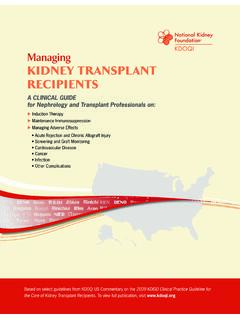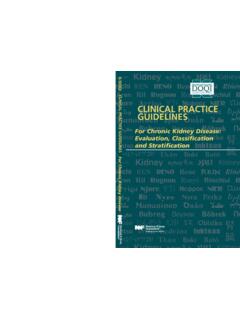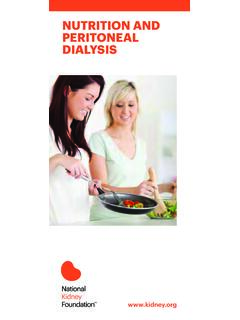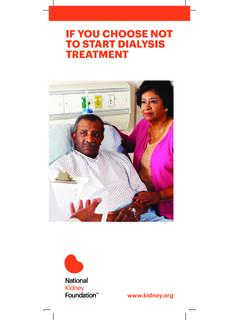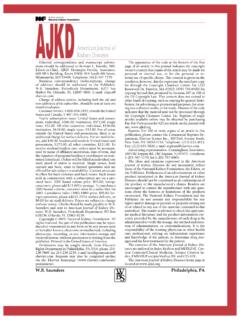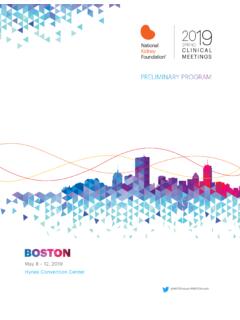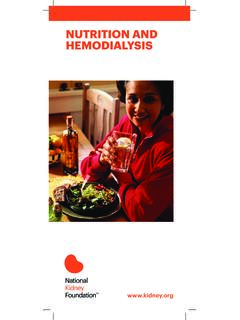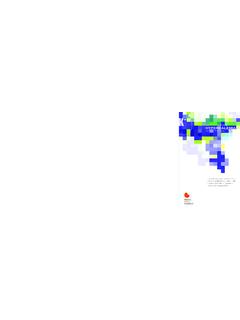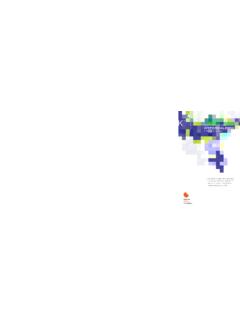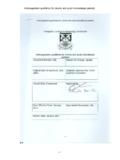Transcription of K D O Q I C linical P ractice G uideline for N utrition in ...
1 2/5/09 8:30 AM Page 1. VOL 53, NO 3, SUPPL 2. Supplement to MARCH 2009. KDOQI Clinical Practice Guideline for Nutrition in Children with CKD: Vol 53, No 3, Suppl 2, March 2009, Pages S1 S124. 2008 Update Saunders an Imprint of Elsevier Abstract T he 2008 update of the Kidney Disease Outcomes Quality Initiative (KDOQI) pediatric nutrition clinical practice guideline is intended to assist the practitioner caring for infants, children, and adolescents with chronic kidney disease (CKD) stages 2 to 5, on long-term dialysis therapy, or with a kidney transplant.
2 The guideline contains recommendations for evaluation of nutritional status and growth and for counseling and selecting nutrition therapies that are appropriate to age and CKD stage. Therapeutic interventions considered include enteral feeding, intradialytic parenteral nutrition, growth hormone therapy, and restriction or supplementation of various macro- and micronutrients. The Work Group drafted narrative reviews based on its expertise and knowledge of the literature in the field and used references to support its write-up.
3 Given the heterogeneity and often unique circumstances of the disease conditions in children with CKD, the Work Group adopted a perspective of issuing recommen- dations of potential use for improving patient survival, health, and quality of life. The recommendations also underwent both internal and external review. Tables of food and formula nutrient content, procedures for anthropometric measurements, copies of growth charts, and a list of resources for calculating energy requirements and anthropometric z scores are provided to assist with implementa- tion.
4 Furthermore, limitations to the recommendations are discussed; comparisons to other guidelines are made; and recommendations are provided for future research. INDEX WORDS: Infants; children and adolescents; chronic kidney disease; dialysis; kidney transplan- tation; nutrition; guideline. American Journal of Kidney Diseases, Vol 53, No 3, Suppl 2 (March), 2009: e1 e1. CONTENTS. VOL 53, NO 3, SUPPL 2, MARCH 2009. KDOQI Clinical Practice Guideline for Nutrition in Children with CKD: 2008 Update S1 Tables S2 Figures S3 Abbreviations and Acronyms S5 Glossary of Definitions S6 Reference Key S7 Work Group Membership S8 KDOQI Advisory Board Members S9 Foreword S11 Executive Summary RECOMMENDATIONS.
5 S16 Recommendation 1: Evaluation of Growth and Nutritional Status S27 Recommendation 2: Growth S31 Recommendation 3: Nutritional Management and Counseling S35 Recommendation 4: Energy Requirements and Therapy S48 Recommendation 5: Protein Requirements and Therapy S53 Recommendation 6: Vitamin and Trace Element Requirements and Therapy Continued Contents, Continued S61 Recommendation 7: Bone Mineral and Vitamin D. Requirements and Therapy S70 Recommendation 8: Fluid and Electrolyte Requirements and Therapy S75 Recommendation 9: Carnitine S77 Recommendation 10: Nutritional Management of Transplant Patients APPENDICES.
6 S84 Appendix 1: Procedures for Measuring Growth Parameters S86 Appendix 2: Resources for Calculating Anthropometric SDS/Percentiles, Energy Requirements, and Midparental Height S87 Appendix 3: Nutrient Content Information S91 Appendix 4: Initiating and Advancing Tube Feedings S92 Appendix 5: Clinical Growth Charts S101 Appendix 6: Description of Guideline Development Process WORK GROUP BIOGRAPHIES AND REFERENCES. S105 Biographical and Disclosure Information S108 References NOTICE. SECTION I: USE OF THE CLINICAL PRACTICE GUIDELINE.
7 This Clinical Practice Guideline document is based upon the best information available at the time of publication. It is designed to provide information and assist decision making. It is not intended to define a standard of care and should not be construed as one, nor should it be interpreted as prescribing an exclusive course of management. Variations in practice will inevitably and appropriately occur when clinicians take into account the needs of individual patients, available resources, and limitations unique to an institution or a type of practice.
8 Every health care professional making use of these recommendations is responsible for evaluating the appropriateness of applying them in the setting of any particular clinical situation. The recommendations for research contained within this document are general and do not imply a specific protocol. SECTION II: DISCLOSURE. The National Kidney Foundation (NKF) makes every effort to avoid any actual or reasonably perceived conflicts of interest that may arise as a result of an outside relationship or a personal, professional, or business interest of a member of the Work Group.
9 All members of the Work Group are required to complete, sign, and submit a disclosure and attestation form showing all such relationships that might be perceived or actual conflicts of interest. This document is updated annually and information is adjusted accordingly. All reported information is published in its entirety at the end of this publication in the Work Group members' Biographical and Disclosure Information section and is on file at the NKF. In citing this document, the following format should be used: National Kidney Foundation.
10 KDOQI. Clinical Practice Guideline for Nutrition in Children with CKD: 2008 Update. Am J Kidney Dis 53: S1-S124, 2009 (suppl 2). Tables Table 1. Recommended Parameters and Frequency of Nutritional Assessment for Children with CKD Stages 2 to 5 and S16. Table 2. Equations to Estimate Energy Requirements for Children at Healthy S36. Table 3. Equations to Estimate Energy Requirements for Children Ages 3 to 18 Years Who Are S36. Table 4. Physical Activity Coefficients for Determination of Energy Requirements in Children Ages 3 to 18 Years.
